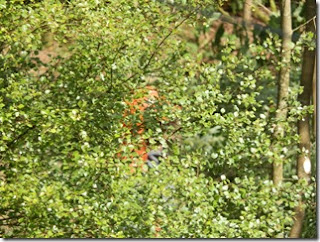It is a while since I wrote to this blog. Inspiration temporarily evaporated after returning home from our tour of Scotland a few months ago, home to an increasingly busy life, an important part of which now is James and his mother Eleanor, soon to be our daughter-in-law when our son Mike makes his vows next year. James has adopted Kate and me as his new grand parents, an honour we do not take lightly, whilst we in turn fall victim to his charming ways and try to remember all the mysterious things that small boys like to do, things our own sons taught us when they were growing up but which have faded from our memories. Sensibly we still have a substantial box of Lego stored away and this never fails to inspire a small mind into creativity when tipped out onto the floor. We now live in a world where small plastic bricks emerge from beneath chairs, under cushions and behind radiators but none of this bothers us unduly.
Our jaunt around Scotland having ended, a rapid warming took over delivering more sunshine than we rightly deserve. When this happens the landscape gradually changes into something dryer, the pine forest acquiring a rich, resinous smell which reminds us of our time in northern Italy a few years ago, and the sphagnum mosses cease to weep moisture, becoming paler green in colour and eventually wilting and looking rather poorly. Much of
Carradale’s woodland is not natural, having been planted as a crop some sixty years ago, so barely within the memory of many local inhabitants. I know this because the timber is now being harvested so the trunks lie horizontally in heaps awaiting collection and I can count the growth rings, which I do. This extraction process is a massive insult to the landscape, being transformational in the same way as a natural disaster would be. To lovers of trees, as I confess we are, the sight of the forest being torn apart by massive machines is quite shocking to witness and the speed at which the operation can be carried out is frightening. When the trees have been felled whole new vistas open up, the likes of which have not been seen for decades. Such is the timescale here that views remembered only by people reaching the end of their lives are now revealed. Who knows what memories are stirred into life by this.
But it is unlikely to be the same remembered landscape. What we now have is a devastated field of broken brash timber and stumps which stand out like pale dinner plates. It is a world torn apart by men with powerful machines showing little care for what is left behind. It is a scarred tableau that must now undergo a lengthy healing process that will gradually soften the edges and smooth over the injuries. Mosses will eventually carpet anything close to the ground, bandaging everything up until only a series of uneven shapes will remain visible, dark green mounds, and through this will sprout saplings whose seeds have lain dormant for want of light. Grasses and wildflowers will come first then as the new growth climbs higher the light reaching the ground will once again become dim and competition for what filters through will intensify.
If nothing were replanted then the forest would regrow in its own way; tree colonisers such as willow and silver birch then ash, gorse, bramble and rhododendron would soon form a green carpet. We know this because the land just beyond our own garden fence was once conifer forest, felled within living memory since when it has lain neglected. All it takes is a clamber over the fence and we are in wild place, untamed and unkempt, difficult of access but fascinatingly peaceful once deep inside the tree cover.
Then one day we awake to the brrrup, brrrup of chainsaw engines revving up close by and we realise that change has come to our little world. Fortunately, instead of clearing the land completely, forestry workers are just thinning out the trees, presumably to promote thicker growth of what is left.
Since this is only a narrow strip of land and the soil layer here is thin, a stand of conifer trees would be vulnerable; the chances are that they would be blown over before reaching maturity. And anyway, why re-plant when nature has already done such a splendid job for you.
Through the leaf cover we catch glimpses of men in their protective orange clothing as the trees sway and fall around them. At first we were concerned that our green backdrop might completely disappear but as it turns out when the work is finished the view from our kitchen window has only subtly changed. Through the leaves we can see sunlight now where there was none before and this is bound to stimulate something to spring into life. We can’t wait to see what it will be.
June is now giving us long dry sunny days in a seemingly endless supply. The solstice has arrived, a time of year when sunlight beams through our rear north-facing windows both in the early morning and throughout the evening. We live at a latitude where dusk, a long period of gradual light reduction which we know as ‘The Gloaming’, seems to last forever and where the darkness of night barely exists at all.




